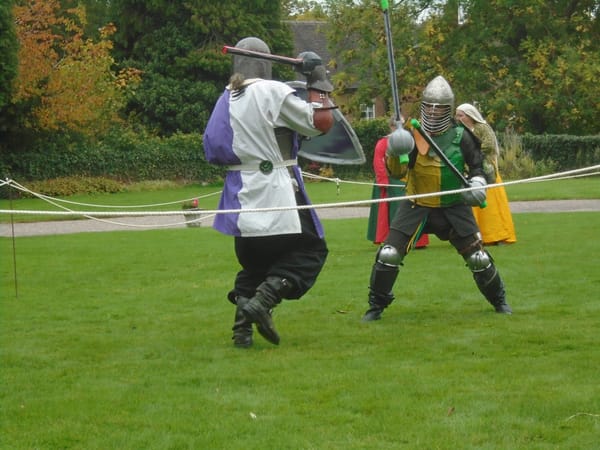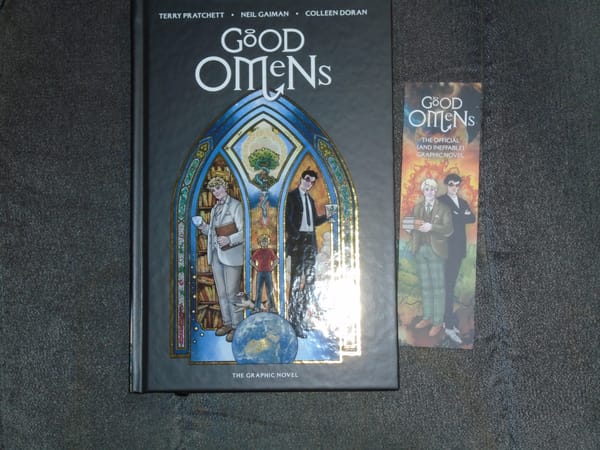The making of Síona

It was this picture that did it. I decided I was going for Ancient British. See those two young women in the top half of the picture, just right of the centre? They're both wearing long dresses with a short(ish) tunic over the top. And I thought... there you go. That is basically my look, because with the tunic you can't see what's going on at the waist. Therefore I can make separates and have discreet Sibyl access available. Of course, nobody actually had to worry about that kind of thing at the time because nobody had a colostomy; either you didn't need one or you were dead. But, then again, nobody was in a wheelchair either. Or even wore glasses (though I believe the Emperor Nero was short-sighted and used a cut emerald to help him to focus on anything at a distance, such as the gladiatorial games). One of the delights of the SCA is that obviously modern aids of that sort are quietly ignored. Nonetheless, I would like my garb to look at least reasonably authentic.
So my new persona is Síona Ní Ríordáin, and she's late 5th to early 6th century, which puts her firmly in post-Roman Britain, or what used to be known as the Dark Ages. (I'd have gone for something even earlier, but I did want her to be a Christian, and that was more important than making her one of Boudicca's Iceni; Boudicca was 1st century, and in her time most of the New Testament hadn't even been written - it would take a few hundred years for Christianity to reach these isles.) A male persona would have worked equally well, but, again, it was those two young women from whom I'd taken my inspiration, and so Síona was born. She is, as you can tell from her name, actually Irish, but she's functionally Ancient British because she came to Britain (specifically Dumnonia, which was a kingdom covering most of the present-day West Country other than what is now Cornwall, which was then the kingdom of Kernow) as an infant. She is the daughter of a well-regarded travelling bard and his wife; the bard, whose name was Finbar, earned the appellation "Ríordáin", which means "royal poet", so if you know any O'Riordans you now know where that name comes from. Finbar's wife Niamh died giving birth to Síona (which, by the way, is pronounced SHEE-o-na; it's the same name as "Sheena", but I have good reason to believe that historically it would have been pronounced with three syllables), and the broken-hearted Finbar travelled to Britain with his infant daughter in the hope that a change of scene would help to ease his grief. He eventually settled into the employment of a noble couple named Dumnovall and Avitoria, who became very fond of him and his daughter; so when he too died when Síona was only twelve years old, they adopted her, having no children of their own. This is basically a device for the benefit of the SCA, because the default in the SCA is that you're some kind of minor nobility. I mean, you can decide not to be, but since you're expected to have a coat of arms, it becomes a little inconsistent if you do. So I had to find some way of turning a travelling bard's daughter into a lady, and that was how I did it.
Dressing and equipping Síona requires a few additional considerations they didn't have at the time, not just Sibyl. For a start, it all has to be vegan. This is mostly not a problem because there are some very good vegan "wool" options available these days, but there's the footwear. Many ancient Britons at that time went barefoot, but Síona, being a lady, would have had shoes; and what she'd have had, specifically, was brown leather turnshoes. (If you ever see a mediaeval-or-earlier costume with black shoes, they've got it wrong. Black leather didn't come in until, if I recall correctly, about the 15th or 16th century.) Turnshoes are so called because they were made pretty much like any other clothing; you sewed up all the seams (normally one at the side and then one to join the upper to the sole, though of course there were variations), and then you turned them the right way out. Which meant, obviously, you used fairly soft leather; they seem to have been almost more like a leather sock than a shoe as we know it, and they tended to encourage you to walk on the balls of your feet rather than your heels. (Ever seen a walking figure in a really old drawing or painting and wondered why they're walking in that rather strange-looking way? That's why.) So I investigated making my own turnshoes and found this absolutely wonderful webpage that explained how to make a bespoke pattern by putting on a sock and covering it with duct tape, then cutting it off your foot along certain specified lines. It looked amazing. But I thought... by the time I've bought the duct tape, and a pair of socks I don't mind cutting up, and half a metre of good quality leatherette, that's going to come in quite expensive. So I looked on Etsy for vegan turnshoes... and found them. Almost certainly cheaper than I can make my own.
When I made my bliauts, I insisted on real linen; but times have changed. I can no longer iron large quantities of real linen, and it looks terrible if you don't (even cotton can be problematic in that respect, though I get round that by pulling it into shape as much as possible while still somewhat damp). So this time I'm probably going to go for a viscose/linen blend, which apparently, by some strange fabric alchemy, creases less than either pure linen or pure viscose. (And pure viscose doesn't necessarily crease much; it depends on the weave.)
Another consideration is that everything should, as far as possible, be usable outside the context of the SCA. With separates that happens pretty much automatically anyway; there'll be at least one cloak, but that's fine, because I wear that sort of thing in any case. (Ancient British cloaks were semicircular, and usually fastened with a penannular brooch, though occasionally other methods were used. The main thing I need to do is to resist the temptation to make them too long; long cloaks look amazing, but don't work very well in a wheelchair.) I also wanted Síona to have a cross pendant, and they really didn't go much for subtle in those days, so it had to be pretty big - much bigger than would normally be worn now. I'd almost despaired of finding anything suitable that didn't cost an arm and a leg when I finally landed on the exact thing I needed. It's intended as a small wall decoration; the height isn't specified but I should think it's 10 - 15 cm. And it is made from, would you believe, Irish turf?! 5000-year-old Irish turf, no less. The same company also makes holy water fonts out of the stuff, so I'm assuming the structural integrity is pretty good; if it'll hold water, holy or otherwise, then it's probably pretty much like wood. I'm going to put it on a string of white howlite nugget beads rather than a chain, and when I eventually retire Síona it can just go on the wall as the manufacturer intended.
I am fudging the socks. They'll barely show in any case. The thing is, knitting wasn't invented till around the 11th century (and in Egypt at that, so it took a little while to make its way over here). Nalbinding, however, was definitely around; there's evidence of that from as far back as 6500 BC. Nalbinding can (but doesn't always) look pretty much identical to knitting. So the question was: how historically accurate did I want to be for a pair of socks? Was I going to a) learn nalbinding in order to make a fully authentic pair, b) fudge it and just wear a knitted pair as usual, or c) go with the toe-rag approach?
You may have heard "toe-rag" used as an insult. I'm a little surprised the word still exists at all. However, until knitting started to take off, toe-rags were what a lot of people used in the winter. You'd just wrap your feet in strips of woven cloth. There's a reference to Brother Cadfael doing it in one of Ellis Peters' historically informed detective stories; it does seem that probably a majority of the population didn't have access to nalbinded socks. (In fact the practice continued a lot longer than that among the poorest of the poor. There are occasional references in Irish folk music to beggars using them; while it isn't always known when the songs were written, the very fact that the words are in modern English suggests no earlier than about the 18th century.)
And then I thought... this is, after all, me we're talking about. Anything that can slip, slide, unhitch itself, or otherwise cause inconvenience, is going to do it on me. I have what you might call high sartorial entropy, and toe-rags are just asking for it to manifest itself, even if I tuck them firmly into the M&S leggings I habitually wear as an under-layer in the winter.
I'm just wearing knitted socks and the heck with it.




